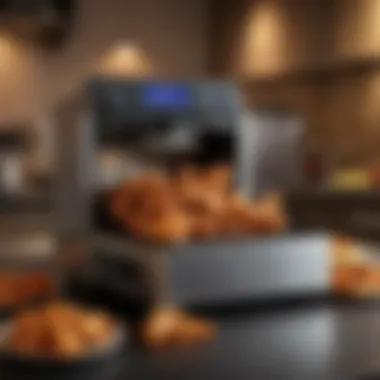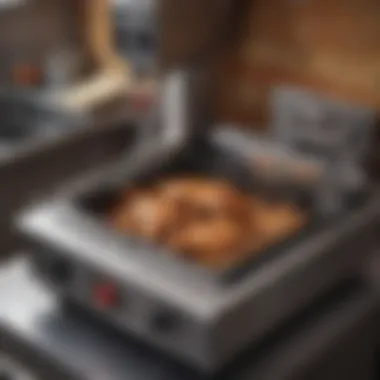The Best Fryers for Chicken Wings: A Comprehensive Guide


Intro
When it comes to crafting the perfect chicken wings, the choice of fryer can make or break the culinary experience. Chicken wings are not just a popular dish; they have transformed into a beloved staple in eateries, bars, and restaurants across the globe. Thus, understanding what makes a commercial fryer optimal for this specific dish is a key concern for many culinary professionals.
In this article, we embark on a deep dive into the factors that influence the selection of commercial fryers specifically designed for chicken wings. From capacity and efficiency to versatility, we’ll explore various types of fryers on the market today. Furthermore, we’ll discuss features that can enhance the flavor and texture of the wings, ensuring that every batch comes out golden and crispy.
We’ll also compare leading models to help different types of businesses decide what suits their needs best and highlight common industry practices that can elevate the frying experience. Not to forget, we'll delve into maintenance tips and essential care for the fryers that are crucial for optimizing performance.
Ready to take a plunge into the frying world? Let's get started!
Understanding Commercial Fryers
In the bustling world of gastronomy, commercial fryers stand as integral machinery that enable culinary professionals to prepare a variety of dishes, with chicken wings being a particular favorite. Understanding how these devices operate is critical not just for frying perfection but also for optimizing production efficiency and ensuring customer satisfaction. With the right fryer, restaurants can not only elevate their menu offerings but also streamline their cooking processes to meet high-demand situations.
Commercial fryers come in different types, offering unique functionalities that cater to specific needs within a kitchen. This section will explore these facets, emphasizing crucial considerations that need to be weighed when selecting the ideal fryer. A well-chosen fryer guarantees consistent quality, whether it's crispy outer skin or juicy, tender meat inside.
Definition and Purpose
A commercial fryer is a device designed specifically for frying food in bulk, utilizing oil to cook quickly and evenly. These fryers range from countertop models to large floor models, intended for different kitchen scales and frying needs. Their primary purpose is not only to fry food but also to do so in a way that ensures efficiency, consistency, and safety in high-volume kitchens. The right commercial fryer can mean the difference between a steady stream of satisfied customers and a kitchen bogged down by inefficiencies or inconsistent results.
Key Considerations for Selection
When selecting a commercial fryer, there are several pivotal elements to consider:
Capacity and Size
Capacity and size are paramount when choosing a fryer that meets your business demands. The frying capacity dictates how many orders you can fulfill in a given time frame. For example, a fryer with a large capacity can handle increased demand during peak hours, reducing wait times for customers. On the flip side, oversized units in smaller kitchens can take up unnecessary space.
Moreover, a fryer needs to fit the capabilities of the kitchen and staff. A compact unit might appeal for its space-saving design but may be limited in output. Striking a balance between size and capacity ensures an efficient frying process without cluttering the workspace.
- Key Characteristics:
- Size options vary from small units suitable for low-output kitchens to large floor models designed for high-volume operations.
- Consider the layout of your kitchen to ensure the fryer fits comfortably within the workflow.
Heating Elements
The heating element is the heart of any fryer. A fryer largely relies on its heating mechanism to deliver the right temperature for optimal frying. Typically, there are two types: tube-style and immersion heating elements. Tube-style offers a more even temperature distribution, reducing the risk of cold spots in the oil, promoting an efficient fry every time.
- Why It Matters:
- A reliable heating element with quick recovery time is crucial to maintain frying temperatures, especially during busy service periods.
- The choice of heating elements can affect cooking times and oil stability, two key factors that influence food quality and safety.
Energy Efficiency
As sustainability becomes a greater concern in the food industry, energy efficiency in fryers has taken a central role. Energy-efficient fryers reduce electricity or gas consumption, leading to significant cost savings over time. Besides, they generate less heat, maintaining a cooler kitchen environment—this can be a blessing during those hot summer months.
- Why It’s Popular:
- Many modern fryers come equipped with advanced technology that helps reduce energy usage without compromising performance.
- Compliance with energy standards not only benefits the environment but also enhances a restaurant’s brand image among eco-conscious consumers.
Selecting the right commercial fryer involves more than simply picking the flashiest model; it requires a nuanced understanding of your kitchen's needs, the features of different fryers, and the overall operational dynamics. A successful choice can drastically influence productivity and product quality, particularly for chicken wings—a beloved dish in eateries across the culinary landscape.
Types of Commercial Fryers
When it comes to frying chicken wings, the right equipment can make a world of difference. Understanding the different Types of Commercial Fryers available is crucial for culinary professionals. Each type comes with unique advantages, tailored to fit diverse kitchen spaces and operational needs. From bustling restaurants to cozy food trucks, knowing the pros and cons of each fryer type ensures that your frying experience is as efficient and effective as possible.


Floor-Model Fryers
Floor-model fryers tend to command a significant presence in commercial kitchens, and for good reason. Designed for high volume, they’re usually more powerful than their smaller counterparts. These fryers can handle large batches of chicken wings all at once, making them ideal for busy environments.
Benefits of floor-model fryers include:
- Higher capacity: They can hold larger amounts of oil, hence more wings can be cooked at any given time.
- Durability: Most models are built with robust materials, ensuring longevity even in hectic kitchens.
- Advanced features: Many come with enhanced temperature controls and filtration systems, which can lead to better oil quality and consistency in frying.
That said, remember these fryers require a bit more space and a utility connection. It’s a big leap for smaller establishments or start-ups.
Countertop Fryers
On the other end of the spectrum sit countertop fryers, which provide an excellent option for those with limited kitchen real estate. Compact yet functional, these units can still deliver a crispy fry without taking up too much space.
Some key points to consider:
- Space-saving: Perfect for small kitchens or food stalls, where space is at a premium.
- Versatile: Many models are electric, allowing for flexible setup options.
- Cost-effective: Typically, they are more affordable than floor-model fryers, addressing budgets without sacrificing quality.
Countertop fryers might have a lower capacity, but for businesses focused on smaller batch sizes or specialized frying techniques, they’re quite the catch.
Gas vs. Electric Fryers
The debate between gas and electric fryers is ongoing in the culinary world. Each has its merits, and the choice hinges on the specific needs of the fryer’s environment.
Gas Fryers:
- Immediate heat: They warm up quickly and allow for high-temperature frying, which can be a game-changer for crispiness.
- Energy efficiency:** Depending on local gas prices, running costs may be lower in some regions.
- Control over cooking: Many chefs prefer gas for the better control it offers over the flame.
Electric Fryers:
- Ease of use: They often require less skill to operate and provide consistent results with simple controls.
- Safety: Electric fryers generally have built-in safeguards, making them less likely to be involved in accidents.
- Installation flexibility: They don’t require a gas line, making them easier to position in various kitchen layouts.
Choosing between gas or electric boils down to specific kitchen needs and preferences. Both have their place, and understanding those nuances can lead to better frying outcomes.
"The right fryer can make all the difference in your chicken wing game—choosing wisely maximizes both flavor and efficiency."
In essence, knowing the Types of Commercial Fryers equips all culinary professionals, whether novice or expert, with the insight necessary to make calculated decisions that could define their cooking successes.
Features That Enhance Frying
In the realm of commercial fryers, especially those dedicated to crafting the perfect chicken wings, certain features stand out as paramount for ensuring consistently excellent results. Having a fryer equipped with advanced components can drastically elevate both the quality of the wings and the efficiency of the frying process. Understanding these features not only aids in choosing the right equipment but also impacts overall productivity and customer satisfaction.
Temperature Control
A fryer’s temperature control is crucial for achieving that desirable crispy outer layer and juicy interior. Precise temperature regulation reduces the risk of wings being undercooked or rubbery. Many modern fryers come with digital displays that allow for exact temperature settings, which can be adjusted on the fly. This technology ensures that the oil maintains an optimal frying temperature, often around 350°F to 375°F for wings.
Temperature control functions vary among models, but those with advanced thermostatic controls can stabilize heat fluctuations, providing more consistent cooking results. This feature is not only beneficial for taste but also enhances food safety by making sure the meat is cooked through.
Filtration Systems
Filtration systems are another key feature that can greatly enhance frying operations. A good filtration system helps in extending oil life by removing food particles and carbon buildup during the frying process. This not only saves money on oil but also means that the wings retain their flavor without becoming tainted by used oil.
Most commercial fryers are equipped with either built-in or external filtration systems. Built-in systems tend to be more convenient, allowing for a quick filtration cycle during busy service hours. This efficiency means less downtime and more wings cooked per hour, catering to the high demands of a bustling kitchen.
Safety Features


Safety should always be a top priority in any kitchen environment. Fryers with enhanced safety measures not only protect staff but also reduce the risk of accidents and operational failures. These features can vary by model, but two stand out as particularly useful: Automatic Shut-Off and Cool-Touch Exteriors.
Automatic Shut-Off
The automatic shut-off feature acts as a protector when temperatures soar beyond safe levels, shutting down the fryer to prevent overheating. This characteristic helps avert potential kitchen fires, making it a significant addition to any commercial fryer. Having such a feature provides peace of mind, especially in high-volume environments where distractions are common.
An automatic shut-off mechanism is increasingly becoming a hallmark of reliable fryers. The unique aspect of this feature is its ability to prevent costly accidents related to overheated oil, which could lead to damage to the fryer itself or, worse, accidents involving injuries.
Cool-Touch Exteriors
The cool-touch exteriors of fryers are another essential element. These designs allow for safe handling of the appliance even while it’s in operation, preventing burns or any heat-related accidents. Given that kitchens can be chaotic, having equipment that is inherently safer to touch makes a notable difference.
With these exteriors, users can handle the fryer’s components without being alarmed. The cool-touch exterior contributes to a safer overall work environment, allowing chefs to focus on producing perfect wings rather than worrying about potential burns.
"Safety features like automatic shut-off and cool-touch exteriors are not just bells and whistles; they are critical for a highly efficient and safe frying experience."
Top Commercial Fryers for Chicken Wings
When it comes to serving up delicious chicken wings, the choice of fryer can make or break your culinary success. Selecting the right commercial fryer not only affects the taste and texture of your wings but also has a significant impact on your kitchen’s workflow and overall efficiency. A well-chosen fryer will help maintain consistent quality while ensuring quick service during peak hours. Let’s delve into the various elements essential in choosing the best commercial fryers for this popular dish.
Model Comparison
In the world of commercial fryers, options abound, leading to various models competing for the top spot. Each model brings something unique to the table, depending on your establishment's specific needs. Here’s a brief overview of some notable features in models that excel in frying chicken wings:
- Frymaster M18: Known for its high-capacity output, perfect for busy kitchens where speed is essential. It features a solid filtration system and offers adjustable temperature controls, allowing for precise frying.
- Pitco SG14: Offers a balance of efficiency and functionality. It's particularly celebrated for its energy-saving capabilities and quick recovery times, making it a great choice for establishments with a high volume of orders.
- Henny Penny FPH-320: This model presents a unique option with a programmable controller, which helps achieve consistent cooking results. It is versatile enough for frying various foods, adding value if your menu expands beyond chicken wings.
Considering these models allows operators to weigh not just capacity and output but also energy consumption and versatility which could be game-changers in a bustling kitchen environment.
Customer Reviews and Feedback
Customer opinions often serve as a glimpse into a product’s real-world performance. When sifting through reviews, key themes generally emerge that can guide potential buyers:
- Consistency: Users frequently comment on how certain fryers maintain consistent oil temperature, which is pivotal for achieving evenly cooked wings without being greasy.
- Ease of Cleaning: A lot of customers express appreciation for fryers that are easy to dismantle and clean. A model that simplifies maintenance can save countless hours and labor costs.
- Durability: Feedback often highlights the importance of a fryer’s robust build. Establishments want equipment that can withstand the daily grind and frequent use.
Ultimately, potential buyers should not overlook reviews, as they provide invaluable insights that can steer important buying decisions while considering what suits their specific operational needs.
Cost Analysis
Cost is always a significant factor when investing in commercial equipment, but evaluating this aspect involves more than the initial price tag:
- Initial Investment: While some fryers may have a higher upfront cost, they might offer superior energy efficiency that can save money in the long run. Brands like Frymaster and Pitco range considerably, but they present a strong case for their costs through technology and build quality.
- Operating Costs: It is essential to consider how much oil you'll use, energy consumption, and maintenance requirements, which can greatly impact overall expense. Models that include advanced filtration systems often require less oil to achieve the same output, making them attractive from an operating expenses standpoint.
- Resale Value: Lastly, some fryers have a higher resale value due to their brand reputation and durability. This can offset the initial investment if the equipment is well-maintained.
Operational Efficiency and Productivity
When it comes to commercial kitchens, operational efficiency is paramount. The way a fryer operates can impact not just the quality of the chicken wings but also the overall productivity of the kitchen staff. It’s about getting the most out of your equipment while minimizing waste, labor, and time.
First and foremost, an efficient fryer can significantly speed up cooking times. With the right model, you can serve up batch after batch of crispy chicken wings promptly. This is particularly beneficial during peak hours when customers are queuing. If your operation is bogged down with slow fry times, you risk losing customers and, consequently, revenue.
Also, an efficient fryer often integrates various functionalities that streamline the cooking process. For instance, automatic timers and temperature controls allow staff to focus on other tasks while wings are frying, enabling better multitasking. Efficient fryers also tend to have superior heat retention capabilities, which means they reach and maintain the desired cooking temperature without long recovery times. This leads to consistently cooked wings each and every time.
Lastly, let's not forget the user experience. A well-designed fryer will require less physical effort to operate and maintain, translating into less strain on staff. This can be a substantial advantage for those busy kitchens where every second counts.
"A good fryer doesn’t just cook; it enables a seamless workflow that keeps orders flying out of the kitchen!"
Batch Frying Techniques


Batch frying is a method that can optimize your operations and enhance productivity. Instead of cooking one order at a time, batch frying allows multiple wings to be prepared simultaneously. This approach is especially crucial during busy times, when demand for chicken wings spikes.
Here are a few considerations for effective batch frying:
- Load Capacity: Understand the maximum load your fryer can handle. Overloading can lead to uneven cooking, while underutilizing may waste energy.
- Timing: Establish clear timing for each batch. Keeping a timer or a kitchen display system can help track fry times effectively.
- Spacing: Ensure that wings have enough space within the fryer. This prevents sticking and promotes even cooking, so every bite is crispy and delicious.
For example, if your fryer can handle one hundred wings per batch and you have a busy Friday night, loading that fryer to capacity can drastically reduce preparation time, leading to quicker service and happier customers.
Reducing Oil Waste
Dealing with oil waste effectively isn’t just an environmental concern; it’s also a matter of cost efficiency. The price of oil can add up quickly, especially in a high-volume kitchen. Adopting strategies to reduce oil waste can save your operation significant amounts in the long run.
Here are some strategies to consider:
- Filtration Systems: Investing in fryers with built-in filtration systems can extend the life of your cooking oil. These systems help to remove food particles that can darken oil and affect its quality, enabling you to reuse oil for a longer period.
- Regular Maintenance: Scheduled cleaning of the fryer can prevent oil from degrading prematurely. Maintaining the fryer’s heating components and ensuring they are clean can help optimize oil performance.
- Monitoring Oil Quality: Utilize oil testing kits to determine when oil should be replaced. This reduces unnecessary disposal of oil that may still be usable.
Overall, balancing operational efficiency with careful oil management creates a more sustainable kitchen environment while also ensuring delicious chicken wings for your patrons.
Maintenance and Care of Fryers
Taking care of commercial fryers is not just a chore, it’s a commitment to quality and safety. Proper maintenance ensures they operate at peak performance and prolongs their lifespan. Without regular attention, these machines can suffer from wear and tear that might affect frying results, safety, and even operational efficiency. Especially when serving something as beloved as chicken wings, having clean, well-maintained equipment helps in delivering both taste and safety.
The investment in a dependable fryer can be significant, and neglecting its care could mean facing costly repairs or replacements in the future. Additionally, unclean fryers can contribute to unpleasant flavors and unhealthy food. There are two main aspects to focus on: cleaning procedures and incorporating regular inspections into your maintenance routine.
Cleaning Procedures
A clean fryer is key to consistently producing delicious chicken wings. Following a structured cleaning routine can avert grease build-up and maintain hygiene standards. Here are the essential steps:
- Daily Cleaning: After each service, drain the oil and check for food particles. Fryers accumulate residues over time that can lead to rancidity if not dealt with.
- Proper Oil Disposal: Use a filtration system or oil disposal service to manage waste effectively. This protects the environment and ensures compliance with local regulations.
- Scrubbing and Wiping: Regularly clean the fryer pot with hot water and a safe detergent. Scrub the inside with a non-abrasive pad to avoid scratches. Pay extra attention to crevices where grime can hide.
- Routine Deep Clean: Perform this at a scheduled interval, perhaps weekly or monthly, depending on usage. Disassemble removable parts, soak them, and scrub all surfaces thoroughly. This may include the oil tanks and heating elements.
Following these procedures will not only enhance the flavor of each batch but also mitigate potential health risks associated with dirty equipment.
Regular Inspections
Conducting regular inspections of fryers serves as a proactive measure against potential issues. Missing a small defect today can lead to larger problems tomorrow. Here’s what to keep an eye on:
- Check for Leaks: Regularly examine the fryer for oil leaks that can signify worn-out seals or damaged connections.
- Temperature Accuracy: Use a calibrated thermometer to verify that the fryer is reaching and maintaining the correct frying temperature. Inaccurate readings can ruin wings and lead to food safety concerns.
- Electrical Connections: Inspect all wiring and connections for signs of wear or damage. This is crucial for electric fryers to prevent any electrical hazards.
- General Integrity: Monitor for rust or corrosion, especially in older fryers, as these can affect performance and safety.
Regular inspections also present an opportunity to educate staff on operational protocols and safety procedures, fostering a culture of accountability and care within the kitchen.
"An ounce of prevention is worth a pound of cure." By prioritizing maintenance and care, kitchen personnel can save not just on equipment costs but also on the reputation that serves their business.
Epilogue
Reaching a well-informed understanding of commercial fryers, especially when looking to optimize chicken wing preparation, can't be understated. In the world of culinary arts, having the right tools deeply influences not just the cooking process but also the final product. A conclusion is where everything converges, wrapping up not only the views presented but also the rationale behind those choices. This journey through the myriad options available in the market has elucidated the intricate facets involved in selecting a perfect fryer.
The summary of key points serves as a stirring reminder of what to prioritize – from capacity and heating efficiency to advanced safety features. Each element plays a significant role in ensuring that operations are flowing without a hitch and that the quality of chicken wings is not compromised.
Summary of Key Points
When considering the purchase of a commercial fryer, one should carefully reflect on the following:
- Capacity and Size: Understanding the volume of chicken wings to be cooked at a single time aids in choosing the right fryer size.
- Heating Elements: Opt for models that offer quick heating times as this enhances productivity in a busy kitchen.
- Energy Efficiency: Selecting fryers that minimize energy consumption can lead to substantial savings in operational costs over time.
- Safety Features: Look for automatic shut-off systems and cool-touch exteriors to protect both workers and products from accidents.
- Filtration Systems: Advanced filtration not only prolongs the oil's life but also improves the overall flavor of the food.
In sum, these points emerge as cornerstones in making a prudent buying decision, which ultimately impacts the operational efficiency of restaurants or food stalls.
Recommendations for Buyers
For individuals or businesses looking to invest in a commercial fryer for chicken wings, here are several recommendations:
- Assess your demands: Analyze the volume of wings typically prepared. This will guide you in choosing between countertop and floor models.
- Prioritize energy efficiency: Models with higher energy ratings might have a slight premium but save money in the long run.
- Read reviews: Pay attention to customer feedback and ratings. They often highlight aspects of durability and performance that weren’t apparent at first glance.
- Evaluate maintenance costs: Some models may require more care than others; consider this while calculating total ownership cost.
- Test before buying: Whenever possible, it’s advantageous to do a trial run to gauge the fryer’s performance in live cooking scenarios.







